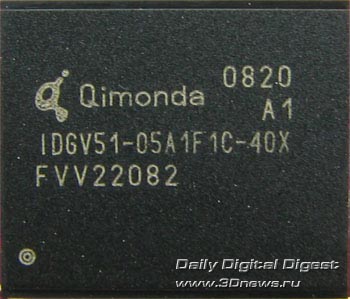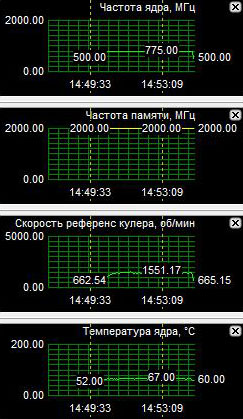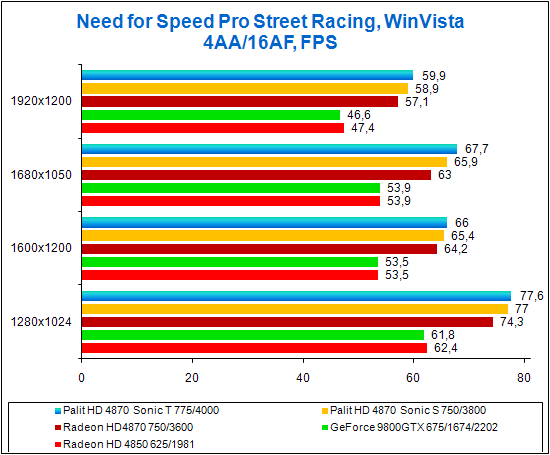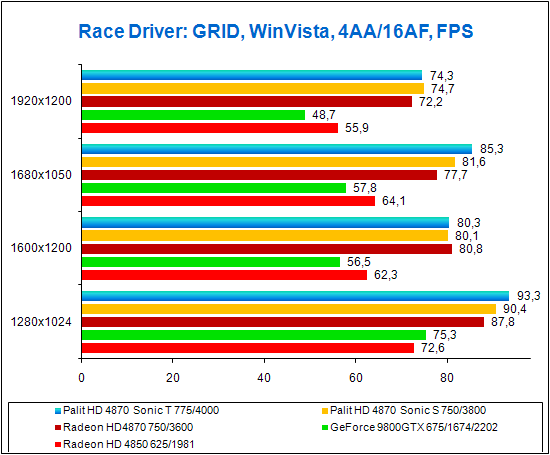All you need to know about your products!

| 3DNews Vendor Reference English Resource - All you need to know about your products! |
||||||
 |
||||||
|
|
||||||
Palit Radeon HD 4870 Sonic: exclusive, with unusual featuresAuthor:Date: 25/10/2008 Recently, we examined Palit Radeon HD 4850 Sonic and were indeed pleased by it. At a price equal to that for the regular Radeon HD 4850, Palit offered its own version of Radeon HD 4850 which stands out for superb overclocking capability and a really efficient cooling system. But Palit also offers a much faster video card - Radeon HD 4870 - in its assortment. Like its "younger sister", Palit Radeon HD 4870 Sonic is made following Palit's proprietary design, is equipped with a proprietary cooling system, as well as some unusual features. Palit Radeon HD 4870 Sonic is packed in a proprietary box with the image of a fully armed frog. To back the menacing image of the video card with specific figures, the designers put a silvery sticker with the mention of the key specifications of the video card. Palit Radeon HD 4870 Sonic, box, rear viewThe reverse side of the box for Palit Radeon HD 4870 Sonic is left for the list of specifications. But these are common for the Radeon HD 4000 and Radeon HD 3000 series, so Palit can use similar boxes for different models of video cards marking them with a silvery sticker on the front side. The package bundle of Palit Radeon HD 4870 Sonic includes the following items:
The list is not long, but the lack of "frills" in the package bundle should favor the price of the video card. Palit Radeon HD 4870 Sonic takes up two expansion slots in the PC housing, is equipped with a cooling system having two fans. The latter is eye-catching since the cooling system with two fans looks very unusual and will offer better cooling. In addition to two DVI-I connectors, Palit Radeon HD 4870 Sonic is equipped with the Display Port connector which will certainly please to the fanciers of respective monitors. Also note the Normal/Turbo switch nearby. Palit Radeon HD 4870 Sonic is equipped with two BIOS chips, and with a switch the user selects the firmware to be used. The difference between the BIOS codes is in the clock speeds at which the video card runs. Note that switching to another BIOS will require to reboot the computer to apply the firmware. The reverse side of Palit Radeon HD 4870 Sonic is not so remarkable. From that it is easy to see that in designing the video card the engineers at Palit used their own PCB design. Palit Radeon HD 4870 Sonic, without a cooling systemTo finally see how unique the PCB design of Palit Radeon HD 4870 Sonic is, just remove the cooling system. The power supply subsystem of the video card looks like made at a high quality, also due to a separate radiator used to cool MOSFET transistors. Note that this radiator is cooled with the second fan of the cooling system of Palit Radeon HD 4870 Sonic. The new product by Palit is equipped with 512 MB of video memory which is made up of eight GDDR-5 chips which are positioned near the GPU AMD RV770.  The video memory chips are made by Qimonda and aimed at operation at the effective clock speed 4000 MHz. Recall that the effective clock speed of GDDR-5 is four times as high as the real, while the previous generations of GDDR video memory had an effective clock speed merely twice as high as compared to the real clock speed. The cooling system of Palit Radeon HD 4870 Sonic has a separate structure in which the fans are not attached to the radiator. The radiator is based on three heat pipes which distribute heat from the center over all its surface. The radiator is chromium-plated, which protects it against oxidation and gives more luster. Tests of the cooling system and overclockingWe'll be testing the cooling system of Palit Radeon HD 4870 Sonic with FUR Renderer Benchmark 1.4.0 in the mode of testing the video card for stability at 1920x1200 and 8X FSAA enabled. The video card was heated up to the point when the GPU temperature stopped going up.  We should admit that the temperature readings of the cooling system tested proved to be simply fantastic. The warming up of Palit Radeon HD 4870 Sonic under load did not exceed 67 C, while the heating of the formerly tested reference Radeon HD 4870 reached the 84 C mark. The noise characteristics of Palit Radeon HD 4870 Sonic did not prove to be so good as the temperature characteristics. It was the second fan to blame for, whose rotational speed was not adjustable automatically depending on the heating of the video card and is always set to the maximum. In the end, the noise from the potentially quiet video card was distinct among the other items of our test bench. Solution to this problem was simple enough. We disconnected the second fan of the cooling system for Palit Radeon HD 4870 Sonic from the board and plugged it in via an ordinary speed regulator for the fan of the motherboard. Once we reduced the speed of the second fan, Palit Radeon HD 4870 Sonic proved to be very quiet, and its temperature response remained to be as good as before the modification.  The heating of the GPU during the tests did not exceed 67 C, and the temperature of the power supply subsystem remained as low as it was with the second fan rotating at its full speed before the modification. As regards the overclocking, Palit Radeon HD 4870 Sonic overclocked to 790 MHz for the GPU and 4400 MHz for the video memory. Recall that Palit Radeon HD 4870 Sonic can operate in the two modes: Normal, and Turbo. Below is a table of clock speeds set for each of the modes, as well as those attained during overclocking:
As you can see, even in the Normal mode the clock speeds of Palit Radeon HD 4870 Sonic are higher than those for the reference Radeon HD 4870. The clock speeds in the Turbo mode, in our view, could have been higher, but to be fair we should admit that they are close to those which we attained with overclocking. The Tests
As contenders to this new product by Palit, Radeon HD 4870, Radeon HD 4850, and GeForce 9800GTX were selected. All the three mentioned video cards were running at reference frequencies recommended by AMD/NVIDIA. Of course, GeForce GTX 260 is missing in the list, but unfortunately we were unable to add it to the results of our tests. Foe tests, we used the drivers Catalyst 8.9 and ForceWare 175.19. We mark Palit Radeon HD 4870 Sonic in the Turbo mode as Palit HD 4870 T 775/4000, and for the Normal mode - as Palit HD 4870 Sonic S 750/3800. We start examining the results with 3DMark tests.  At 3DMark 06, there is not much difference between the three variations of Radeon HD 4870 video cards. To be fair, we should admit that Palit Radeon HD 4870 Sonic proved to be the winner in the Turbo mode.  At 3DMark Vantage, performance, the difference between the tested video cards is more evident. The winner is Palit Radeon HD 4870 Sonic in the Turbo mode, and GeForce 9800GTX proved to be the weakest.  At 3DMark Vantage, high, the winner is again Palit Radeon HD 4870 Sonic in the Turbo mode. Again, the weakest was GeForce 9800GTX. To be fair, we note that Radeon HD 4850 also lags well behind the leader, but the difference among the three variations of Radeon HD 4870 is not so dramatical.  At 3DMark Vantage, extreme, the alignment of forces remained the same as in the previous two modes.  At Call of Duty, all the three Radeon HD 4870 demonstrate much better results than Radeon HD 4850 and GeForce 9800GTX. The positive effect in this case was played by not only the higher clock speeds than those in the three Radeon HD 4870, but also the faster video memory GDDR-5 versus GDDR-3 in Radeon HD 4850 and GeForce 9800GTX.  At Call of Juarez, the situation is similar. The winner was Palit Radeon HD 4870 Sonic in the Turbo mode, with Radeon HD 4850 and GeForce 9800GTX proved to be the losers.  At Crysis, the situation is similar: the faster GDDR-5 video memory proved to be really useful in this game either. The winner is Palit Radeon HD 4870 Sonic in the Turbo mode.  The game Need for Speed Pro Street Racing was no exception, and the three Radeon HD 4870 video cards proved to be winners at it. Note that it is one of the few games where Radeon HD 4850 and GeForce 9800GTX demonstrate approximately similar results. In most cases, Radeon HD 4850 beats GeForce 9800GTX.  At Race Driver: GRID, Radeon HD 4870 shows superb results and overclocking enhances its leading positions. In this game, like in all the previous games, the winner is Palit Radeon HD 4870 Sonic in the Turbo mode where the higher clock speeds gave additional score points. Final WordsWe believe Palit Radeon HD 4870 Sonic will appeal to the amateurs of all the non-trivial. This video card is unusual all throughout: it is based on the unique design by Palit, is equipped with a proprietary highly efficient cooling system, with the Display Port connector which is rarely seen in video cards by other manufacturers, as well as two BIOS codes, which is also unusual (although similar precedents were found earlier as well, e.g. in Galaxy video cards). But those who prefer quietness would have to spend a bit more time and enable the second fan of the cooling system of the video card, as we did. This flaw by the manufacturer is easy to fix, so won't be too strict. We recommend Palit Radeon HD 4870 Sonic to those who are ready to spend a bit of time and efforts to acquire a quiet and fast video card. Evidently, the cooling system of Palit Radeon HD 4870 Sonic is better than that in the reference, and the increased clock speeds add more performance to it. Finally, we bring in approximate prices for the tested video cards and the video cards of the GeForce GTX260 series in the Moscow retail:

- Discuss the material in the conference
|
||||||||||||||||||||||||||||||||||||||||||||
|
|||||